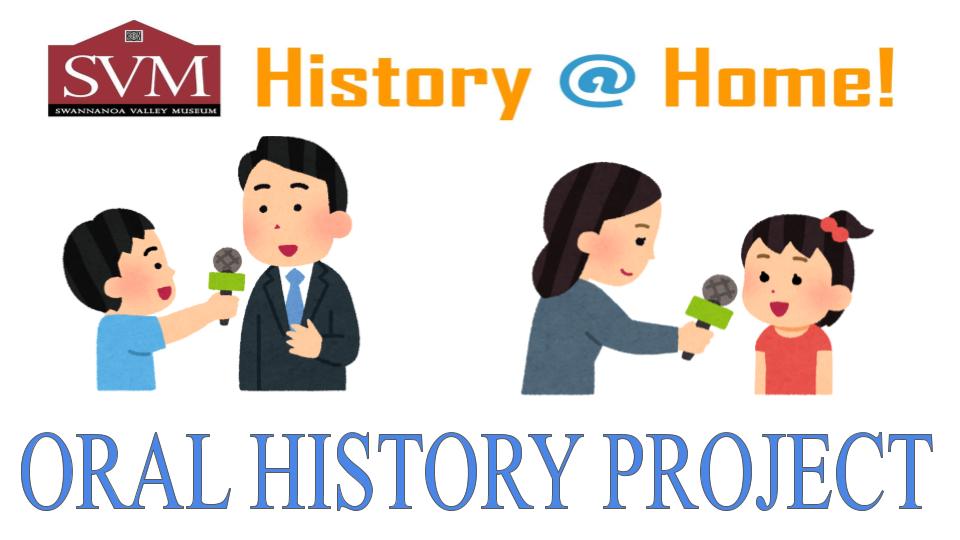
Episode 1: “History never looks like history when you’re living through it”
Quote by: John William Gardner
Oral History:
As we sit at home wondering when this pandemic will be over, we are actually experiencing history in the making. What we go through today will be analyzed for many generations to come. One way to preserve these experiences is through Oral History. Oral history is the study of history by listening to people’s personal recollections as told through speech and dialogue. Every person in our community is a source of oral history! Oral history gives historians insight into how people responded, endured, thrived,
and survived through the historical events that took place during their lifetimes.
Oral History Activity:
1) Pick a person to interview.
2) Age of the person interviewed does not matter. All ages have different perspectives of the events happening around them. All of their insights are valuable.
3) Pick an Interview Subject: What period of time you want to interview your subject about.
a) Examples: Corona Virus Pandemic, Life at School, Wars they lived through, Presidency’s they experienced etc..
4) Research:
a) Learn about the person you are going to interview.
b) Learn about the subject you want to interview them about.
5) Write your interview questions:
a) Be sure to ask the person you are going to interview about their name, date of birth, place of birth, current location they live, and Job.
b) Be sure to record your name and date of the interview.
c) A good way to begin an interview is with an open-ended question, such as “Tell me who your people are and where you were raised.” Gaining context about someone’s life and family helps an interviewee feel comfortable at the beginning of an interview, and gives you,the interviewer, a stronger context for the interviewee’s life.
d) Make sure the questions are relevant to the time period you are interested in talking about.
e) Plan questions that are open ended and try to avoid “yes” or “no” questions.
6) Schedule a date and time for the interview.
a) Interviews can be done in many different ways. You can Skype, Face Time, Zoom conference,telephone, face to face etc…
7) Interview Prep
a) Bring a recording device. Most smartphones have a microphone that you can use to record interviews. You can also download apps that can record phone conversations. Most interface apps like Skype and Zoom have recording capabilities as well.
b) Bring you questions
c) Bring a pen and paper with which to take notes.
8) Begin the interview:
a) Greet the interviewee
b) Ask permission to record them and get verbal consent
c) Ask permission to share the oral history with others- but have specific examples in mind. Some people may be ok with you sharing the interview with a local archive or museum, but not online. At the end of the interview, you can also check in with the interviewee and ask if they shared anything in the interview that they would prefer not to be included.
d) Begin interview questions
e) Practice active listening! Make good eye contact, do not talk over the interviewee, and ask follow-up questions about what the interviewee shares. Do not feel that you need to stick to your script if you come up with new questions to explore your chosen topic matter.
f) Always thank the interviewee for their time.
9) After the interview:
a) Review the interview. Take notes on what you would like to ask next time.
b) Type a transcription of the interview. A transcription software that offers a free trial is
Express Scribe. Express Scribe offers a playback feature that slows down recordings, making it easier to transcribe the interview.
c) Save the interview and transcription in multiple places, so that a backup will always be
available.
10) Share the interview with others.
State of NC Essential Standards:
First Grade Essential Standards
1.H.1.1 Explain how and why neighborhoods and communities change over time.
Third Grade Essential Standards
3.H.1.1 Explain key historical events that occurred in the local community and regions over time.
3.H.2.2 Explain how multiple perspectives are portrayed through historical narratives.
Fourth Grade Essential Standards
4.H.1.3 Explain how people, events and developments brought about changes to communities in various
regions of N.C.
Sixth Grade Essential Standards
6.H.1.1 Construct charts, graphs, and historical narratives to explain particular events or issues over time.
6.H.1.3 Use primary and secondary sources to interpret various historical perspectives.
6.H.2.2 Compare historical and contemporary events and issues to understand continuity and change.
Eighth Grade Essential Standards
8.H.1.2 Summarize the literal meaning of historical documents in order to establish context.
8.H.3.4 Compare historical and contemporary issues to understand continuity and change in the development
of North Carolina and the United States.